航空维修概论
- 格式:doc
- 大小:167.00 KB
- 文档页数:6
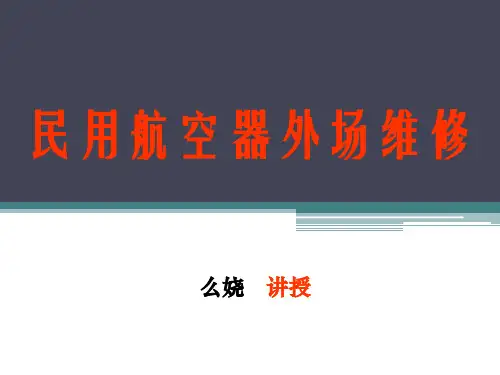
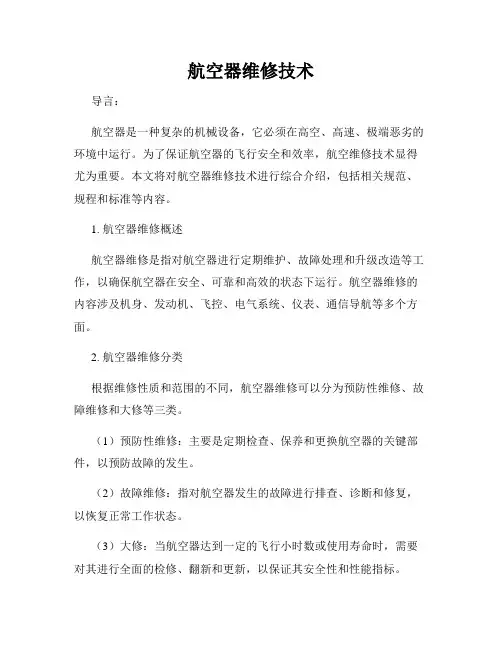
航空器维修技术导言:航空器是一种复杂的机械设备,它必须在高空、高速、极端恶劣的环境中运行。
为了保证航空器的飞行安全和效率,航空维修技术显得尤为重要。
本文将对航空器维修技术进行综合介绍,包括相关规范、规程和标准等内容。
1. 航空器维修概述航空器维修是指对航空器进行定期维护、故障处理和升级改造等工作,以确保航空器在安全、可靠和高效的状态下运行。
航空器维修的内容涉及机身、发动机、飞控、电气系统、仪表、通信导航等多个方面。
2. 航空器维修分类根据维修性质和范围的不同,航空器维修可以分为预防性维修、故障维修和大修等三类。
(1)预防性维修:主要是定期检查、保养和更换航空器的关键部件,以预防故障的发生。
(2)故障维修:指对航空器发生的故障进行排查、诊断和修复,以恢复正常工作状态。
(3)大修:当航空器达到一定的飞行小时数或使用寿命时,需要对其进行全面的检修、翻新和更新,以保证其安全性和性能指标。
3. 航空器维修流程航空器维修流程是指维修人员按照一定的程序和方法对航空器进行维护和修复的过程。
一般包括故障报告、排故、修复、测试、验证和归档等环节。
4. 航空器维修技术标准航空器维修技术标准是航空维修工作的基础,它规定了维修的要求、方法和标准。
主要包括以下几个方面:(1)维修手册:由航空器制造商制定的详细的维修指南,包括维修步骤、维修工具和维修材料等内容。
(2)技术规范:针对不同类型的航空器,制定了相应的技术规范,包括维修方法、维修流程和维修质量要求等。
(3)安全规程:规定了航空器维修的安全要求,包括维修人员的资质、设备的安全使用和维修现场的安全管控等。
(4)质量标准:指导维修人员进行质量控制和质量评估的标准,以确保维修工作符合质量要求。
5. 航空器维修技术的进展随着航空器制造技术的不断发展和航空器运行状况的变化,航空器维修技术也在不断进步。
新技术、新材料和新工艺的应用为航空器维修提供了更高效和更可靠的解决方案。
例如,无损检测技术的应用可以及时发现隐藏在航空器结构中的缺陷,以防止故障的发生。
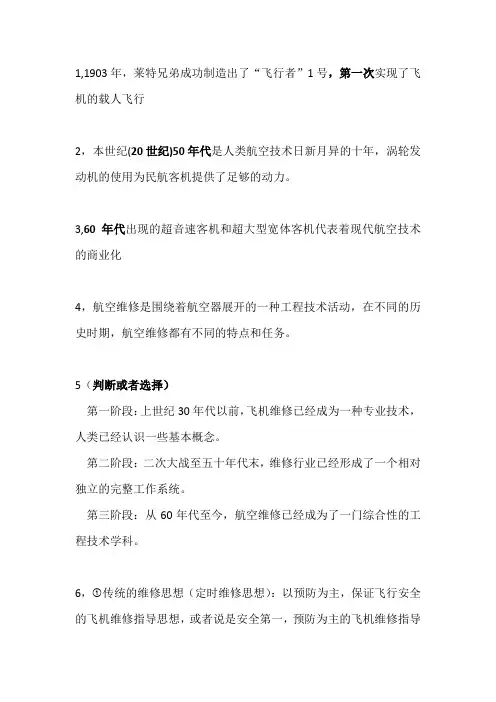
1,1903年,莱特兄弟成功制造出了“飞行者”1号,第一次实现了飞机的载人飞行2,本世纪(20世纪)50年代是人类航空技术日新月异的十年,涡轮发动机的使用为民航客机提供了足够的动力。
3,60年代出现的超音速客机和超大型宽体客机代表着现代航空技术的商业化4,航空维修是围绕着航空器展开的一种工程技术活动,在不同的历史时期,航空维修都有不同的特点和任务。
5(判断或者选择)第一阶段:上世纪30年代以前,飞机维修已经成为一种专业技术,人类已经认识一些基本概念。
第二阶段:二次大战至五十年代末,维修行业已经形成了一个相对独立的完整工作系统。
第三阶段:从60年代至今,航空维修已经成为了一门综合性的工程技术学科。
6, 传统的维修思想(定时维修思想):以预防为主,保证飞行安全的飞机维修指导思想,或者说是安全第一,预防为主的飞机维修指导思想。
传统的预防维修思想是:飞机的安全性与其各系统,部件,附件,零件的可靠性密切相关,可靠性又与飞机的使用时间直接相关,而且在预防维修与飞机可靠性之间存在着根本性的因果关系。
因此必须通过按使用时间进行的预防性维修工作,即通过经常检查,定期修理和返修来控制飞机的可靠性。
这是一种以定期全面翻修为主的预防维修思想或定时维修思想。
7,定时方式(HF):(1)传统的定时维修只适用于一些单体零部件,简单零部件和有支配性故障模式的复杂零部件。
(2)零部件的可靠性与安全性的联系,通过余度设计,破损安全设计和其他方法可以削弱和切断。
(3)飞机的固有可靠性的安全性水平是有效维修所能达到的最高水品。
(4)预防性维修必须根据零部件故障规律和零部件的实际情况,采取有针对性的正确方式,不是预防工作做得越多越好。
8,现代维修思维:是以可靠性为中心的维修思想。
这种思想,是建立在综合分析航空器固有可靠性的基础上,根据不同零部件的不同故障模式和后果,而采取不同维修方式和维修制度的科学预防维修思想。
它的实质,就是采取最经济有效的维修,对航空器的可靠性实施最优控制。
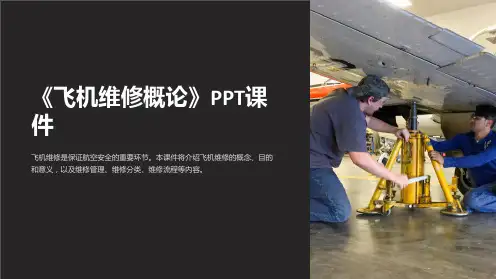
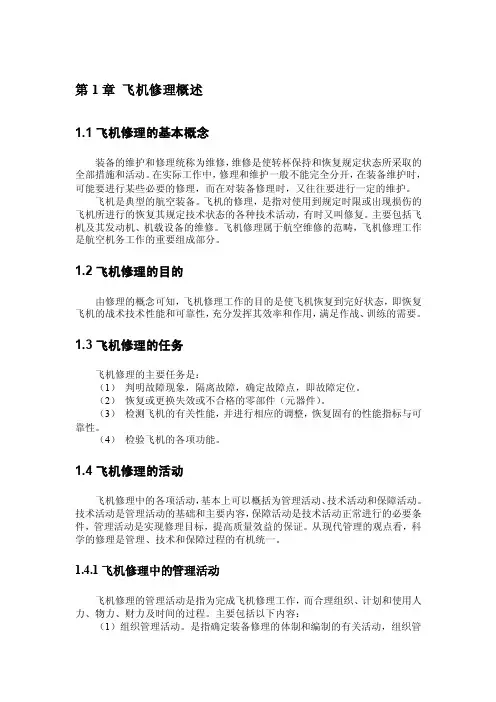
第1章飞机修理概述1.1飞机修理的基本概念装备的维护和修理统称为维修,维修是使转杯保持和恢复规定状态所采取的全部措施和活动。
在实际工作中,修理和维护一般不能完全分开,在装备维护时,可能要进行某些必要的修理,而在对装备修理时,又往往要进行一定的维护。
飞机是典型的航空装备。
飞机的修理,是指对使用到规定时限或出现损伤的飞机所进行的恢复其规定技术状态的各种技术活动,有时又叫修复。
主要包括飞机及其发动机、机载设备的维修。
飞机修理属于航空维修的范畴,飞机修理工作是航空机务工作的重要组成部分。
1.2飞机修理的目的由修理的概念可知,飞机修理工作的目的是使飞机恢复到完好状态,即恢复飞机的战术技术性能和可靠性,充分发挥其效率和作用,满足作战、训练的需要。
1.3飞机修理的任务飞机修理的主要任务是:(1)判明故障现象,隔离故障,确定故障点,即故障定位。
(2)恢复或更换失效或不合格的零部件(元器件)。
(3)检测飞机的有关性能,并进行相应的调整,恢复固有的性能指标与可靠性。
(4)检验飞机的各项功能。
1.4飞机修理的活动飞机修理中的各项活动,基本上可以概括为管理活动、技术活动和保障活动。
技术活动是管理活动的基础和主要内容,保障活动是技术活动正常进行的必要条件,管理活动是实现修理目标,提高质量效益的保证。
从现代管理的观点看,科学的修理是管理、技术和保障过程的有机统一。
1.4.1飞机修理中的管理活动飞机修理的管理活动是指为完成飞机修理工作,而合理组织、计划和使用人力、物力、财力及时间的过程。
主要包括以下内容:(1)组织管理活动。
是指确定装备修理的体制和编制的有关活动,组织管理的主要要素包括目标、人员、职位、职责、关系、信息等。
世界各国的装备维修体制和编制各不相同,是不断发展的。
(2)计划管理活动。
是指在维修思想、维修方针的指导下,对修理各项工作的内容、步骤和实施程序加以科学安排和规定的有关活动。
(3)技术管理活动。
是对修理中各项技术活动过程和技术工作需求进行科学管理的有关活动。
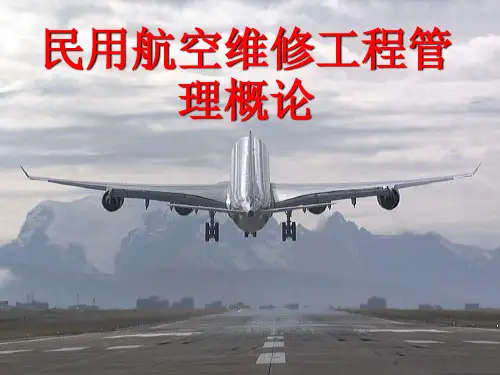

1,1903年,莱特兄弟成功制造出了“飞行者”1号,第一次实现了飞机的载人飞行2,本世纪(20世纪)50年代是人类航空技术日新月异的十年,涡轮发动机的使用为民航客机提供了足够的动力。
3,60年代出现的超音速客机和超大型宽体客机代表着现代航空技术的商业化4,航空维修是围绕着航空器展开的一种工程技术活动,在不同的历史时期,航空维修都有不同的特点和任务。
5(判断或者选择)第一阶段:上世纪30年代以前,飞机维修已经成为一种专业技术,人类已经认识一些基本概念。
第二阶段:二次大战至五十年代末,维修行业已经形成了一个相对独立的完整工作系统。
第三阶段:从60年代至今,航空维修已经成为了一门综合性的工程技术学科。
6, 传统的维修思想(定时维修思想):以预防为主,保证飞行安全的飞机维修指导思想,或者说是安全第一,预防为主的飞机维修指导思想。
传统的预防维修思想是:飞机的安全性与其各系统,部件,附件,零件的可靠性密切相关,可靠性又与飞机的使用时间直接相关,而且在预防维修与飞机可靠性之间存在着根本性的因果关系。
因此必须通过按使用时间进行的预防性维修工作,即通过经常检查,定期修理和返修来控制飞机的可靠性。
这是一种以定期全面翻修为主的预防维修思想或定时维修思想。
7,定时方式(HF):(1)传统的定时维修只适用于一些单体零部件,简单零部件和有支配性故障模式的复杂零部件。
(2)零部件的可靠性与安全性的联系,通过余度设计,破损安全设计和其他方法可以削弱和切断。
(3)飞机的固有可靠性的安全性水平是有效维修所能达到的最高水品。
(4)预防性维修必须根据零部件故障规律和零部件的实际情况,采取有针对性的正确方式,不是预防工作做得越多越好。
8,现代维修思维:是以可靠性为中心的维修思想。
这种思想,是建立在综合分析航空器固有可靠性的基础上,根据不同零部件的不同故障模式和后果,而采取不同维修方式和维修制度的科学预防维修思想。
它的实质,就是采取最经济有效的维修,对航空器的可靠性实施最优控制。


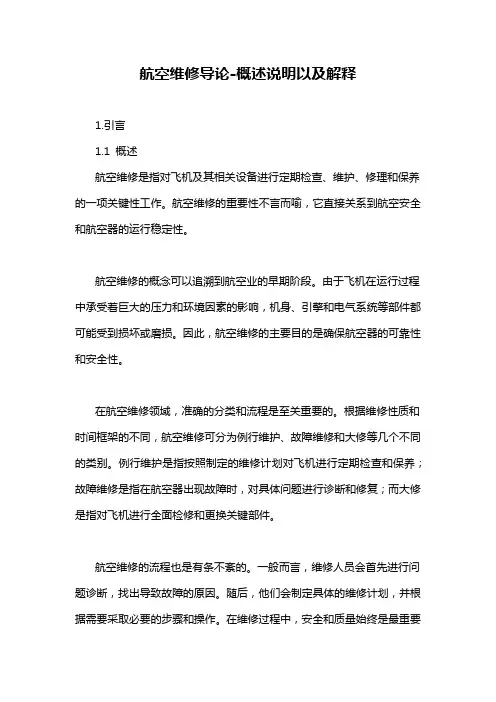
航空维修导论-概述说明以及解释1.引言1.1 概述航空维修是指对飞机及其相关设备进行定期检查、维护、修理和保养的一项关键性工作。
航空维修的重要性不言而喻,它直接关系到航空安全和航空器的运行稳定性。
航空维修的概念可以追溯到航空业的早期阶段。
由于飞机在运行过程中承受着巨大的压力和环境因素的影响,机身、引擎和电气系统等部件都可能受到损坏或磨损。
因此,航空维修的主要目的是确保航空器的可靠性和安全性。
在航空维修领域,准确的分类和流程是至关重要的。
根据维修性质和时间框架的不同,航空维修可分为例行维护、故障维修和大修等几个不同的类别。
例行维护是指按照制定的维修计划对飞机进行定期检查和保养;故障维修是指在航空器出现故障时,对具体问题进行诊断和修复;而大修是指对飞机进行全面检修和更换关键部件。
航空维修的流程也是有条不紊的。
一般而言,维修人员会首先进行问题诊断,找出导致故障的原因。
随后,他们会制定具体的维修计划,并根据需要采取必要的步骤和操作。
在维修过程中,安全和质量始终是最重要的考量因素。
最后,维修完成后,还需要进行全面的检验和测试,以确保飞机能够正常运行。
航空维修行业面临着许多挑战,其中包括技术更新的速度、成本控制和人员培训等问题。
随着飞行器的技术日新月异,维修人员需要不断学习和掌握新的技术和设备。
此外,航空维修也面临着严格的成本控制要求,维修工作必须在预算范围内完成,同时确保维修质量。
因此,培训优秀的维修人员和建立高效的管理体系非常重要。
总之,航空维修是航空行业中不可或缺的一环,它直接关系到飞机的安全和可靠性。
在这个动态变化的行业中,准确的分类和流程、面对各种挑战的能力,以及高素质的维修人员都是至关重要的。
只有这样,我们才能确保飞机在空中飞行时具备最高水平的安全性和可靠性。
1.2文章结构文章结构部分的内容可以包括以下内容:文章结构在本篇文章中,我们将按照以下结构来论述航空维修的导论内容:引言首先,我们将介绍本文的背景和意义。

航空维修概论AirportsSafety : the top priorityMoving people and goods can be risky.To meet the specific needs of aircraft maintenance we have been designing access equipment for operations such as stripping and painting.platformsIndependent access platformssuspended to hangar roofs viaoverhead cranes. Vertical, horizontaland slewing movements authorise fullaccess to any part of the aircraft.Static and mobile work platforms,suspended from roof or floor mountedfor heavy maintenance operations.Aicraft maintenance hangars andaircraft engine-workshops.RepairsFor repairs, Comtek often acts on the customer's behalf to provide the manufacturer with the repair schemes that win quick approval for implementation by our expert technicians. Designed for durability, Comtek's repairs not only restore structural strength but in many cases actually improve the in-service performance of the part and reduce life cycle costs.Comtek combines practical experience and technological innovation to provide airlines around the world with the highest quality repair and overhaul services available anywhere. Incoming parts are assessed for damage by professional project engineers, who submit a firm fixed price quotation and completion date in writing for your approval before work begins. If you prefer, mobile repair teams using the latest in portable equipment are available to work on-site at your facility.Mobile Repair TeamsQuick TurnaroundFirm Fixed PricingPrimary or Secondary Structure24 Hour AOG SupportFree Engineering SupportStandard turnaround time is 3-4 weeks, but our service is designed to flexibly respond to urgent requests. You're kept fully informed at all times of the status of your repair, so you will never have any unpleasant surprises - that's what we mean by our service pledge to provide you with "Worry Free Composites Support!"For damage outside SRM limits, we engineer new repairs using the same design and analysis software employed by the aircraft manufacturers, supported by structural test data generated in our own laboratory. We often apply the latest in materials and process technology to create a unique, cost-effective repair - so before you order a new part, call us first!Scheduling ofAircraft HeavyMaintenanceOverviewAircraftrequire regularinspection and maintenance, based on calendar age, hours flown, and cycles of takeoff-landing. Engines, landing gear, and other major systems have limits on their life in service before overhaul. There is a stream of modificationscoming from the manufacturers. All this work needs to be packaged up into a series of maintenance checks, cycling through work that can be done in a single shift without a hangar, to a work package requiring several weeks in a hangar. Efficient packaging and scheduling of this work plays an important part in maximising the availability of the fleet for flying.The planner is faced with a mixture of work which can be planned well in advance, changing out the landing gear, and work which needs to be squeezed in as soon as possible, the manufacturer has advised of the wrong type of O-ring in a pump. A tool to assist in preparing schedules has to be fast, efficient in its long range planning, flexible to handle the ad hoc work, and complete in its handling of all of the work to be scheduled.As much as possible of the workings of the scheduler should be able to be modified by the planners, rather than computer programmers. The inputs, operation, and outputs of the scheduler need to be auditable, to ensure that no airworthiness regulations are breached. The more transparent and intuitive the method used, the more confidence and reliance planners will have in using it.A "black box" approach to aircraft maintenance scheduling would have problems of modifiability, auditability and reliability. OASIS is not just a "white box", where the planners can see the workings inside. To a large extent, the planners build the workings of the scheduling machine, and assume responsibility for the quality of the schedules produced.OASIS is built on top of Orion, a knowledge-based system, and uses a knowledge network to create and schedule Limit based maintenance events as well as independent events. The OASIS scheduler will attempt to place the Limit based events as close to their limits as possible whilst ensuring that they do not use more than the available resources at any point in time. Hints within the network will attempt to book resources initially back from the hard limit by a planning pad, but eat up the planning pad if there is no alternative. The resources being booked can be Facilities such as Hangars or Human resources, or consumable spares, perhaps with refurbishment requirements like undercarriage, with the refurbishment process built into the model.Specification of Maintenance ChecksThe planner prepares descriptions of the resource use and internal constraints for the various maintenance checks for various sorts of aircraft. These descriptions are expanded into lines of maintenance for individual aircraft, taking into account the particular aircraft history and projected flying time. The planner can prepare check descriptions that are time stamped and are used only before or after a particular date, or can prepare a detailed description that applies only to a particular check for one particular aircraft. The knowledge network is built out of these descriptions, and the knowledge network is usedto create the schedule, so the planner has full control of whatgoes into creating the schedule.Representation Of Multiple BasesWhere a maintenance check can occur at several bases, the resource availability can be pooled, or by using a positive tonegative range for Resource Intensity, bases can trade availability among themselves, thecalculations for doing so all embedded in thenetwork.Swallowing Of ActivitiesA larger check, brought forward, should swallow any minor checks within range. This is easily accomplished by making the duration of the smaller check include zero as a possibility, and if a larger check comes close enough, forcing the duration of the smaller check to zero. Additional modelling allows some particular work in the smaller check to move to the larger one, while other work, which would also occur in the larger check, disappears.Piggybacking Of EventsYou will sometimes want to attach some packet of work to one of the checks that must occur on the plane, but may be unsure as to which check it should be. The starting dates of the checks are tentative, and there may be constraints on the event to be piggybacked which conflict with parts of those ranges. You can build logic into the network so the appropriate check will be chosen after the starting dates are known to moreaccuracy.The Knowledge ModellingApproachModelling the knowledge aboutthe application directly leads tothe construction of the"scheduling machine". Most ofthe logic in the model isgenerated by planners, as theydescribe the various checks tobe carried out, in terms ofactivities and resource use andinterrelation with other checks.This information is combinedwith plane histories and expected flying time to create the network model. There is no complex algorithm to build, because the scheduling method is non-algorithmic - the interaction of the elements of the model lead to the solution of the scheduling problem, and the planners assembled those elements. The model can be assembled quickly, and changed quickly in response to variations in work practices or fleet makeup.。
航空维修导论全文共四篇示例,供读者参考第一篇示例:航空维修是航空工程中的一个重要环节,它涵盖了航空器的维护、修理、检查和测试等一系列工作,是保障航空器飞行安全和保值的关键部分。
在航空维修导论中,我们将会介绍航空维修的基本概念、发展历程、主要工作内容、维修标准与流程,以及航空维修技术的未来发展方向。
一、航空维修的基本概念航空维修指的是对飞机及其相关设备进行维护、检修和修理的工作。
航空维修是为了确保飞机正常飞行、减少故障发生、延长飞机使用寿命和保障飞行安全而进行的一项工作。
航空维修主要包括预防性维修、故障维修和大修等内容。
二、航空维修的发展历程航空维修的发展始于20世纪初的飞机诞生之时,随着航空业的不断发展壮大,航空维修业也在不断完善和发展。
目前,航空维修已成为航空工程的重要组成部分,其技术水平和服务质量也在不断提高。
三、航空维修的主要工作内容航空维修的标准与流程是为了保证维修质量和飞行安全而建立的。
航空维修的标准一般由民航局或其他相关部门制定,维修流程包括维修计划编制、维修工作执行、维修记录保存等环节。
随着航空业的不断发展和技术的不断进步,航空维修技术也在不断更新和完善。
未来,航空维修技术将会更加智能化、数字化和自动化,提高维修效率和准确性,降低成本和风险,提升服务质量和客户满意度。
第二篇示例:航空维修是指对飞机进行保养和维护的工作,是确保飞行安全的重要环节。
随着航空业的迅速发展,航空维修行业也逐渐壮大,成为一个独立的职业领域。
本文将介绍航空维修的基本概念、工作内容、发展趋势以及相关技术知识。
一、航空维修的基本概念航空维修是指对飞机进行检查、检测、维修和保养的工作。
其目的是确保飞机的安全性和性能,延长飞机的使用寿命,降低飞行风险。
航空维修包括日常检查、定期检查、故障排除和维修、大修和改装等内容。
航空维修技术员需要掌握机械、电气、电子等多方面的知识,具备良好的动手能力和逻辑思维能力。
二、航空维修的工作内容航空维修的工作内容包括以下几个方面:1.日常检查:包括机身结构、机载系统、发动机和飞行控制系统等各部分的检查,发现并排除潜在故障。
AirportsSafety : the top priorityMoving people and goods can be risky.To meet the specific needs of aircraft maintenance we have been designing access equipment for operations such as stripping and painting.platformsIndependent access platformssuspended to hangar roofs viaoverhead cranes. Vertical, horizontaland slewing movements authorise fullaccess to any part of the aircraft.Static and mobile work platforms,suspended from roof or floor mountedfor heavy maintenance operations.Aicraft maintenance hangars andaircraft engine-workshops.RepairsFor repairs, Comtek often acts on the customer's behalf to provide the manufacturer with the repair schemes that win quick approval for implementation by our expert technicians. Designed for durability, Comtek's repairs not only restore structural strength but in many cases actually improve the in-service performance of the part and reduce life cycle costs.Comtek combines practical experience and technological innovation to provide airlines around the world with the highest quality repair and overhaul services available anywhere. Incoming parts are assessed for damage by professional project engineers, who submit a firm fixed price quotation and completion date in writing for your approval before work begins. If you prefer, mobile repair teams using the latest in portable equipment are available to work on-site at your facility.Mobile Repair Teams∙Quick Turnaround∙Firm Fixed Pricing∙Primary or Secondary Structure∙24 Hour AOG Support∙Free Engineering SupportStandard turnaround time is 3-4 weeks, but our service is designed to flexibly respond to urgent requests. You're kept fully informed at all times of the status of your repair, so you will never have any unpleasant surprises - that's what we mean by our service pledge to provide you with "Worry Free Composites Support!"For damage outside SRM limits, we engineer new repairs using the same design and analysis software employed by the aircraft manufacturers, supported by structural test data generated in our own laboratory. We often apply the latest in materials and process technology to create a unique, cost-effective repair - so before you order a new part, call us first!Scheduling ofAircraft HeavyMaintenanceOverviewAircraftrequire regularinspection and maintenance, based on calendar age, hours flown, and cycles of takeoff-landing. Engines, landing gear, and other major systems have limits on their life in service before overhaul. There is a stream of modificationscoming from the manufacturers. All this work needs to be packaged up into a series of maintenance checks, cycling through work that can be done in a single shift without a hangar, to a work package requiring several weeks in a hangar. Efficient packaging and scheduling of this work plays an important part in maximising the availability of the fleet for flying.The planner is faced with a mixture of work which can be planned well in advance, changing out the landing gear, and work which needs to be squeezed in as soon as possible, the manufacturer has advised of the wrong type of O-ring in a pump. A tool to assist in preparing schedules has to be fast, efficient in its long range planning, flexible to handle the ad hoc work, and complete in its handling of all of the work to be scheduled.As much as possible of the workings of the scheduler should be able to be modified by the planners, rather than computer programmers. The inputs, operation, and outputs of the scheduler need to be auditable, to ensure that no airworthiness regulations are breached. The more transparent and intuitive the method used, the more confidence and reliance planners will have in using it.A "black box" approach to aircraft maintenance scheduling would have problems of modifiability, auditability and reliability. OASIS is not just a "white box", where the planners can see the workings inside. To a large extent, the planners build the workings of the scheduling machine, and assume responsibility for the quality of the schedules produced.OASIS is built on top of Orion, a knowledge-based system, and uses a knowledge network to create and schedule Limit based maintenance events as well as independent events. The OASIS scheduler will attempt to place the Limit based events as close to their limits as possible whilst ensuring that they do not use more than the available resources at any point in time. Hints within the network will attempt to book resources initially back from the hard limit by a planning pad, but eat up the planning pad if there is no alternative. The resources being booked can be Facilities such as Hangars or Human resources, or consumable spares, perhaps with refurbishment requirements like undercarriage, with the refurbishment process built into the model.Specification of Maintenance ChecksThe planner prepares descriptions of the resource use and internal constraints for the various maintenance checks for various sorts of aircraft. These descriptions are expanded into lines of maintenance for individual aircraft, taking into account the particular aircraft history and projected flying time. The planner can prepare check descriptions that are time stamped and are used only before or after a particular date, or can prepare a detailed description that applies only to a particular check for one particular aircraft. The knowledge network is built out of these descriptions, and the knowledge network is usedto create the schedule, so the planner has full control of whatgoes into creating the schedule.Representation Of Multiple BasesWhere a maintenance check can occur at several bases, the resource availability can be pooled, or by using a positive to negative range for Resource Intensity, bases can trade availability among themselves, thecalculations for doing so all embedded in thenetwork.Swallowing Of ActivitiesA larger check, brought forward, should swallow any minor checks within range. This is easily accomplished by making the duration of the smaller check include zero as a possibility, and if a larger check comes close enough, forcing the duration of the smaller check to zero. Additional modelling allows some particular work in the smaller check to move to the larger one, while other work, which would also occur in the larger check, disappears.Piggybacking Of EventsYou will sometimes want to attach some packet of work to one of the checks that must occur on the plane, but may be unsure as to which check it should be. The starting dates of the checks are tentative, and there may be constraints on the event to be piggybacked which conflict with parts of those ranges. You can build logic into the network so the appropriate check will be chosen after the starting dates are known to moreaccuracy.The Knowledge ModellingApproachModelling the knowledge aboutthe application directly leads tothe construction of the"scheduling machine". Most ofthe logic in the model isgenerated by planners, as theydescribe the various checks tobe carried out, in terms ofactivities and resource use andinterrelation with other checks.This information is combinedwith plane histories and expected flying time to create the network model. There is no complex algorithm to build, because the scheduling method is non-algorithmic - the interaction of the elements of the model lead to the solution of the scheduling problem, and the planners assembled those elements. The model can be assembled quickly, and changed quickly in response to variations in work practices or fleet makeup.。